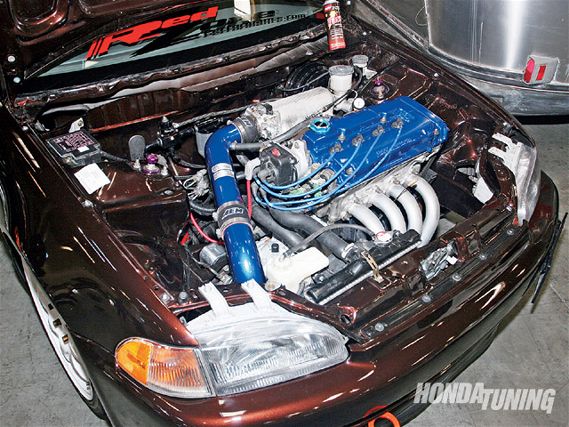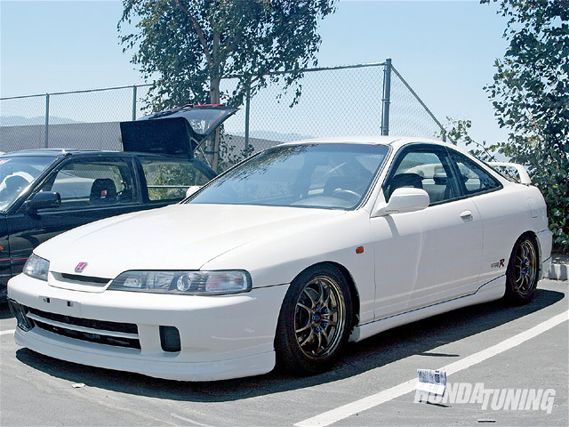 | 1995 Honda Accord H22A - Exhaust Notes
| 1995 Honda Accord H22A - Exhaust Notes
A Case For The Third-Gens
Hi there, Honda Tuning. I'm writing because I'm a member of www.preludepower.com and there has been a petition on there for you guys to do an article on third-gens. When I first heard about this I thought the article would bring attention to our cars and their cult following, which I thought was great. You know, to cover old Preludes and to kind of give a tribute to the older Hondas people seem to take care of like older muscle cars. It turns out, however, that this was just an attempt for some people to try to get you guys to feature one of their cars. Your most recent issue, which I just picked up and was very, very pleased with, has two submissions in the Exhaust Notes section asking why Honda Tuning doesn't feature different cars. The explanation you gave should be sent to the guys on www.preludepower.com, because people there don't seem to understand why you haven't featured a third-gen yet. It seems like everyone who is posting on that petition saying things like, "Oh, my car will be painted and ready in a week, blah, blah, blah," has a car that you could barely tell apart from a stock one and doesn't realize their car might not be magazine worthy. You have to go all out in every category to make it in a magazine. You can't just have an engine swap, wheels, and a lip. I'm just tired of reading this stuff I guess. Thanks for your time and keep up the good work. Oh yeah, I love the advice section from the professional photographer.
-Ian Olsen, Roseville, MI
Lashing Out
First off, I love the magazine. I'm in the middle of an LS-VTEC build and I've got a set of Civic Type R camshafts to put in my GS-R head. What should the clearance for the valve lash be set to? Thanks for the help.
-Rodney Stewart, whereabouts unknown
The valve lash and adjusting procedures are the same for all B-series VTEC engines, including the B18C and B16B Type R ones. Honda specifies clearances to be between .006-.007 inches on the intake side and .007-.008 inches on the exhaust side. Do what they say, no tighter, no looser. Improper adjustments can cause a number of problems including lean conditions, uneven compression, and burnt valves. First-time valve adjusters often have trouble knowing what the feeler gauge should "feel" like as it's being slid in between the rocker arm and camshaft lobe. Here's a trick to help you get it down: Find yourself a good micrometer and set it to pretty much any value, but let's do .007 inches just for the heck of it. Slide a .007-inch feeler gauge through the micrometer, carefully paying attention to the amount of friction and effort required to pass it through. This is exactly how it should feel when measuring the valve lash. Be sure to recheck your clearance after the adjusting nut is tightened as it can change.
Auto VS. Stick
I have a '95 Accord with an H22A engine swap. I've had if for about three years now, and last year I upgraded to a JDM LSD automatic transmission. The engine is fully built with rods, sleeves, and pistons, and I'm currently pushing only 10 psi since I'm not sure if it's going to hold. My goal is to keep it an automatic since there aren't too many of them out there. There's nothing better than when I go to the track and people are amazed that it's an auto and how fast it goes. I smoke five-speeds every time. Can the JDM tranny hold power or what should I do to make it stronger? Would it be cheaper to just put a five-speed tranny in it? I have another project and I've already spent a lot of money on my Accord. The rest is going toward my '05 Infiniti G35 coupe. My goal is to make it in Honda Tuning.
-Candy Malave, whereabouts unknown
 | 1995 Honda Accord H22A - Exhaust Notes
| 1995 Honda Accord H22A - Exhaust Notes
The JDM transmission isn't necessarily stronger than the U.S.-spec one but that doesn't mean it'll fail on you right away. Your biggest problem is going to be getting the torque converter to hold the kind of power you want. You can try to find somebody who specializes in beefier torque converters but it'll probably be cheaper and most likely easier to just do the five-speed conversion along with a clutch that's capable of the kind of torque you're making. With the right mounts and brackets you can swap any '90-'97 Accord or '92-'96 Prelude manual transmission into place. If you decide to do the conversion, be sure to pick up a pedal assembly, shift cables and shifter assembly, clutch master cylinder and lines, as well as the correct transmission mount, all from the manual-trans-equipped model. You also might want the gauge cluster from a manual trans model. You should be able to make all of this happen for well under $1000, in day's work, with parts that are readily available.
Torsion Bar Q&A
First, I love your mag and I'm a long-time reader. I have an '87 Civic with a torsion bar suspension and I want to lower it. I was told that all I need to do is to take the bars out and turn them a couple of splines and that would get the job done. I want to bring it down so there is no more gap. I think there is more to it than that or am I wrong? If that's all there is to it, which way do you turn them and by how much? I am also thinking about an engine swap but I'm not sure what to go with. I have a D15A2 in it now. I just want to find something that will drop in with little to no extra work. Or would it be better to rebuild my engine? Thanks for your help.
-Jeff C., U.S. Army, Ft. Bragg, NC
Yep, the '84-'87 Civics all have torsion bar suspensions up front instead of coil springs. Torsion bars occupy less space, reduce unsprung weight, make for a smaller overall package up front, and they're amazingly simple. | 1995 Honda Accord H22A - Exhaust Notes
There's really no harm in using a blockguard, although sleeving your block is certainly a more durable, albeit more expensive, solution. Blockguards first gained popularity during the early years of Honda engine building. Machine shops that were capable of installing ductile iron sleeves were few as were the number of manufacturers that produced Honda-specific forged pistons and rods. Many early turbocharged D- and B-series engines consisted of no more than a set of forged pistons and a blockguard. When tuned properly, the setup was fairly reliable. Today, there are more than a few Honda sleeves on the market and, if you can't find a machine shop competent enough to install them, you can find one online and ship your block off to them. Will your engine be fine if you forgo the sleeves and opt for the blockguard? Probably. But it doesn't make a whole lot of sense to skimp on sleeves in light of the rest of your setup.
ITBS?
I have a D16Y8 that I want to get the most out of. A friend of mine is selling some individual throttle bodies for it but he's telling me that, once I put them on, it can be hard to get them to work, especially if you don't have experience with them. I'm asking you for some good, honest advice. Should I buy them or not?
Your friend, Raul Moran, whereabouts unknown
It depends, especially since you didn't mention what brand they are. Some ITBs can be difficult to set up initially, but once they're properly tuned, and provided you have a sound engine management system and a reputable tuner, you shouldn't have any problems. MAP-based ITBs are definitely trickier to tune than TPS-based ones but, once they're properly tuned, any of them will "work." Also, keep in mind that some of the lower-end ITB throttle plates often stick, which is never a good thing.
Touge H22A
I have a '94 Integra LS coupe and I've been entertaining the idea of swapping in a JDM H22A Type S with an H2B transmission adapter. Will I still be able to touge and eat up the corners? With the added weight of the H22A, is there a way I can balance the weight in the rear with a larger rear antiroll bar, preferably the ASR 32mm? A lot of people say that if you're swapping the H, forget the touge. Damn that, I know there's a way, I just need some guidance. To help you guys answer my question, I'll give details about my suspension setup. As of right now, I have Ksport Full Kontrol coilovers, BLOX lower control arms, Omni Power camber kits, Brembo rotors, Hawk HP pads, an ASR rear subframe, an ASR 24mm antiroll bar, ASR end links, Toyo R1R 205/50-15 tires, and Enkei 15x7 RPF1 wheels with a +35 offset. Any input or advice will be greatly appreciated.
-Donne Morriso, Long Beach, California
Sure you can. Depending on which accessories and transmission you're using, the H-series could be as little as 50 lbs heavier than your B-series setup. No, the extra weight over the front axles isn't a good thing for you, but it can be overcome with a little bit of ingenuity. The added weight is going to increase understeer, but you can fight that off with a few tricks. You're right about the rear antiroll bar; play around with a stiffer one out back and soften up the front. Try the same thing with your spring rates. You also might try adding some negative camber up front and keeping the rear near zero and, of course, shift any weight that you can from the front of the car to the rear. You also might look into an H-to-B transmission adapter kit. The B-series transmission isn't a whole lot lighter than the H's, but every pound counts.
Got Questions, Comments, Love, Or Hate?
Send Your Letters To:
editorial@hondatuningmagazine.com
Or Snail Mail To:
Honda Tuning
2400 E. Katella Avenue, Suite 1100
Anaheim, CA 92806
